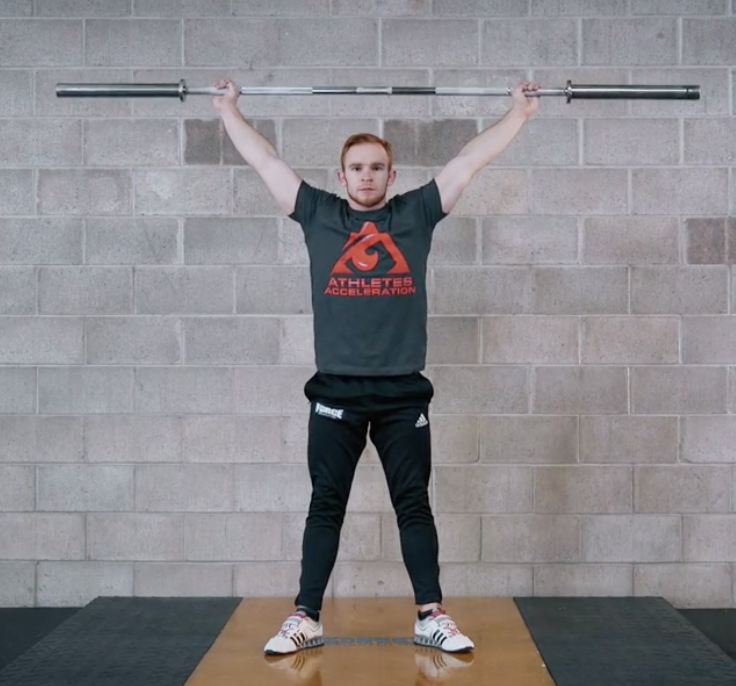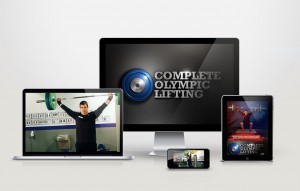How to Do Warm-Up Complexes Olympic Style – Correctly!
By: Alfonso “Trey” Zepeda III, USAW

I have a question for all coaches and athletes.
What prevents you from warming up properly before a weightlifting session? Which one of these answers do you use? “I don’t have enough time” “Its not important” “Boring” “It makes me to tired for my workout”, etc.
Even I have justified by saying, “I am pressed for time lets skip the warm up and get to the meat and potatoes of the workout. Because everyone knows power and strength aren’t built in the warm up…Right!” I have even taken it a step further by justifying with an extra light set at the beginning of each exercise. Now don’t misunderstand me I’m sure you will get away with this warm up style for a while. But what has been gained by cutting this corner? Keep in mind its not just about the meat and potatoes, you have to throw in some side dishes and a drink to make a complete meal. Weightlifting works on the same principals. Its all the little mechanical details that make weightlifting such an effective style of training. And cutting out the details doesn’t make a complete meal. Before I go any further let me clarify the term weightlifting. Its not just moving machine or free weights around for exercise…that’s weight training. Weightlifting is also referred to as Olympic lifting, its one in the same just with a different name. Now that we are straight on the training lingo let me move on to the importance of “Warm Ups Olympic Style”.
Olympic weightlifting has been around way more years than any one actually knows. It has been a staple of my programs for most of my career as a coach and athlete. Especially when I moved into the D-1 university ranks of training and coaching. There are a lot of coaches and athletes who avoid this form of training. Do to the learning curve being too difficult. Calvin Coolidge said, “Nothing in this world can take the place of persistence.” And keep in mind the simple fact that weightlifters have always demonstrated more power than most species on earth. With the exception of a few individuals and the low land gorilla, Olympic Style Weightlifters are great examples of those who demonstrate athletic POWER. More is accomplished in fewer exercises than any other style of training. And I would like to say for the record, the more exposure a high school athlete can have in the forms of Olympic training the more prepared they will be for athletics after high school. There is not a coach out there that can tell me they don’t want more POWER in their athletes.
Not only do the athletes need this style of training, the coaches need it as well, if not even more. So now ask yourself these three questions:
1. What do you want to achieve? 2. How are you going to get this? 3. How hard are you willing to work to get there?
Warm Up Complexes Olympic Style will introduce athlete and coach to some of the small but most important mechanical details to Weightlifting and help them through the learning curve.
A warm up of the body prior to exercise is a must to get the body ready for the increase in stress that lies ahead. Warming up is not to burden you but to improve performance and decrease injury.
A general warm up is best to start with exercising the major muscle groups of the body. These movements should not be related in the training session itself, i.e. jogging, jump rope, stationary bike, etc. The warm up needs to be intense enough for the body to heat up and cause sweat but not cause fatigue.
The USA Weightlifting Coaching Manual says, “A thorough warm up will improve performance through the following mechanisms:
- Increased rate and strength of muscle contraction
- Increased muscle coordination through related movements
- Increased metabolic rate
- Increased efficiency of the neuromuscular system
- Increased work capacity
- Improve cardiovascular and respiratory efficiency, e.g., the adaptation of the heart to exercise stress is improved and likewise oxygen delivery to working muscles is a benefit.
- Reducing the possibility of injury through increased muscle elasticity and improving the joint range of motion. This is particularly important for the development of skill efficiency in Weightlifting.
- Psychological benefits”
After a general warm up some form of stretching would be good to implement. Any form of exercise that will help increase the range of motion of a joint. Stretching should be done always after the warm up. “Cold Muscles” injure easily and stretching them before they are warm can produce stretching and tearing injuries.
The next order of business following general warm up and stretching is specific warm up. This relates to the movements specific to the exercises planned for the workout. Depending on the exercise, coaches or athletes may pick to use a stick, dumbbells, or bar with/without weights when doing these exercises. There are many different types of weight training warm ups available. Thanks to Coach Tom Cross of MidAmerica Nazarene University, I was introduced to weightlifting complexes that benefit all types of athletes. Weightlifting complexes are not only for warm ups. They make for quick and easy circuit training on those, “pressed for time days”. Some examples are:


Complex I – Barbell 1. Muscle Snatch (medium grip) 2. Shrug & Upright Row 3. Snatch Squat 4. Back Squat and Push Press (cheeks to heals) 5. Bend over Row (flat back- elbows out)
Six reps of each lift before putting down the bar Followed by: Plate Overhead Walking Lunge, 2×12
Complex II – Dumbbells Same exercises as Complex I
Six reps of each lift before putting down the bar Followed by: Sprint Style Walking Lunge, 2×12
Here are some coaching points to help you with the complex lifts.
Muscle Snatch:
- Grip is with ring finger over the ring on the bar.
- Keep the bar on (close to) the body the entire movement. Shrug and place the bar overhead behind the ear.
- Learn to lower the bar by bending the hips first, knees second. Learn to raise the bar by extending the knees first, hips second.
- Keep elbows locked until the legs are completely extended.
- Remember – anything almost right is wrong.
Shrug & Upright Row:
- Grip is thumbs touching.
- Good upright posture, shrug shoulders and lift elbows above ears.
- Lower the bar slower than you raise it.
Snatch Squat (Overhead Squat):
- Grip wide as possible-arms locked at elbow
- Starting position – bar over ear-shoulders shrugged-try to pull the bar apart (make it longer)
- Heels under hips-toes out-chest up-chin in-eyes straight ahead
- As you lower hips, push knees wide and chest tall-lower your hips, do not lean.
- Keep weight on heels, go very deep.
- Pause at bottom for balance and control of your body.
Back Squat to Push Press:
- Grip rather narrow with elbows under the bar.
- With good erect posture squat slow and low.
- Return under control; near the top, snap your hips violently to drive the bar off your shoulders.
- From that point press the bar over the ear with arms straight and pause at the top.
- Lower and repeat.
Bent Over Row (BOR):
- Grip is the same as for Muscle Snatch.
- ‘Set’ the back and bend from hips keeping back flat.
- Keeping the elbows above the wrists and bar, pull the elbows up as high as possible-do not be concerned with where the bar travels.
- Remember to keep back flat and tight.
Recommended Athletes' Acceleration Products
About the Author
Alfonso “Trey” Zepeda III, USAW, is an Assistant Strength and Conditioning Coach at The University of Texas in Austin, Texas. Trey works with UT men’s track & field, swimming, and golf. He has worked with high school and elite level athletes as well. To contact email: alpha1505@hotmail.com
—————————————————————————–



0 Comments for “How to Do Warm-Up Complexes Olympic Style – Correctly!”